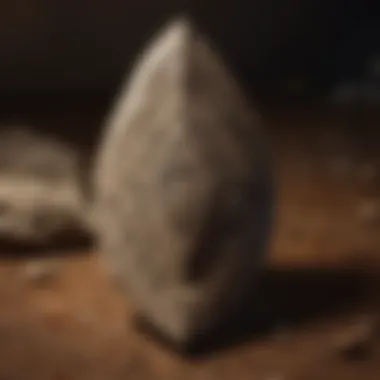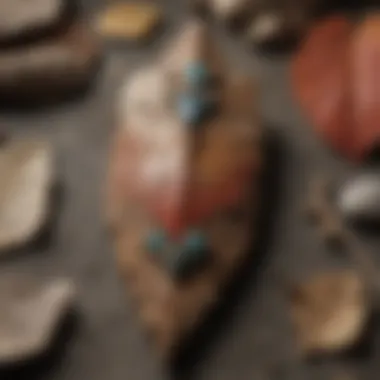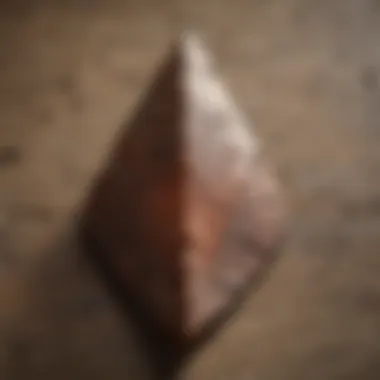Unveiling the Enigmatic World of Arrowheads: A Comprehensive Identification Chart


Rock and Fossil Identification
Delve into the fascinating realm of rock and fossil identification, an essential aspect for understanding arrowheads. In this section, we will explore the various types of rocks and fossils that are commonly associated with arrowhead formations. From igneous to sedimentary rocks, each type bears distinct characteristics that provide vital clues for collectors and enthusiasts. Furthermore, we will delve into the specific characteristics to look for when identifying these rocks and fossils, such as color, texture, and mineral composition. Additionally, we will discuss the tools essential for accurate identification, including magnifying glasses, hardness tests, and UV lights.
Collecting Tips and Techniques
For avid collectors and enthusiasts, mastering the art of collecting arrowheads is a rewarding journey filled with excitement and discovery. In this section, we will uncover the best practices for collecting arrowheads, emphasizing the importance of research, patience, and respect for archaeological sites. Moreover, we will provide valuable insights on locating prime collecting sites, ranging from riverbanks to archaeological sites with documented historical significance. Additionally, we will offer practical advice on how to safely extract specimens, highlighting the significance of ethical and responsible collecting practices.
Preservation and Display
Preserving and displaying arrowheads is an art form that honors their historical significance and aesthetic beauty. This section will delve into various techniques for preserving rocks and fossils, ensuring their longevity and pristine condition. From cleaning and stabilizing to utilizing archival materials, collectors will learn how to safeguard their precious finds for future generations. Furthermore, we will explore proper storage methods, including humidity control and protection from light and pests. To enhance the visual appeal of collections, we will present creative display ideas, such as shadow boxes, mounted frames, and interactive exhibits.
Geological Insights
Gain profound insights into the geological aspects of arrowheads, unraveling the captivating connection between rocks and fossils. Discover the geological formations and processes that have shaped arrowheads throughout history, from volcanic eruptions to glacial movements. Delving deeper, we will examine the historical significance of rocks and fossils in unraveling ancient civilizations and cultural practices. Furthermore, we will spotlight notable discoveries in the field of arrowhead identification, shedding light on groundbreaking research and remarkable findings that have expanded our understanding of prehistoric cultures and human evolution.
Introduction
Delve into the fascinating world of arrowheads with this exquisite identification chart that serves as a valuable resource for enthusiasts and collectors alike. This article embarks on a journey to explore the various types of arrowheads, unearth their historical significance, and provide essential tips for accurate identification, making it an indispensable guide for those intrigued by the mysteries of arrowheads.
Understanding Arrowheads
In delving into the realm of arrowheads, it is imperative to grasp their significance throughout history and the field of archaeology. Understanding the pivotal role arrowheads have played in shaping civilizations and aiding in human survival sheds light on their enduring importance.
Role in History
The role of arrowheads in history is a testament to their unparalleled utility as tools for hunting and warfare. These small yet mighty artifacts have been integral to human existence, shaping the outcomes of battles and providing sustenance through hunting practices. Their precision in striking targets with lethal force highlights their unique characteristic of being both efficient and deadly in the hands of skilled marksmen. Their ongoing relevance in history serves as a valuable elucidation for enthusiasts seeking to comprehend the intricate evolution of weaponry.
Importance in Archaeology
Arrowheads hold immense importance in the realm of archaeology, acting as key artifacts that provide insights into ancient cultures and human behavior. Their presence at archaeological sites offers valuable clues about trade routes, hunting techniques, and societal structures of past civilizations, making them indispensable for piecing together historical narratives. The durability of arrowheads and the information they reveal through their craftsmanship and materials provide archaeologists with a window into the past, allowing for a deeper understanding of how our ancestors lived and interacted with their environment.


Types of Arrowheads
Arrowheads come in various types, each with its own unique characteristics and historical significance. Understanding the different types of arrowheads is crucial for enthusiasts and collectors to appreciate the diversity and craftsmanship behind these artifacts fully. In this article, we delve deep into the world of arrowheads, shedding light on the variety of types available, their cultural importance, and providing valuable insights for identifying and appreciating them.
Projectile Points
Projectile points are a fundamental category of arrowheads, including Classic Paleo Points, Folsom Points, and Clovis Points. These points played a pivotal role in ancient hunting and warfare, showcasing the ingenuity and skills of early civilizations. Each type offers distinct characteristics, shapes, and flaking patterns that set them apart and make them essential additions to any arrowhead collection.
Classic Paleo Points
Classic Paleo Points represent a significant era in arrowhead craftsmanship, known for their sturdy construction and sharp tips. They are a popular choice among collectors due to their historical value and aesthetic appeal. The unique feature of Classic Paleo Points lies in their finely crafted tips, which enabled them to pierce through tough materials with precision. While these points may have limitations in terms of size variation, their consistency in design makes them a sought-after choice among enthusiasts.
Folsom Points
Folsom Points hold a special place in arrowhead history, recognized for their distinctive fluting and intricate designs. They are highly valued for their craftsmanship and precision in flaking patterns, reflecting the skill and artistry of ancient artisans. The key characteristic of Folsom Points lies in their delicate fluting along the edges, a testament to the advanced techniques employed during their production. While Folsom Points may require careful handling due to their intricate nature, their aesthetic appeal and historical significance make them prized possessions in any arrowhead collection.
Clovis Points
Clovis Points stand out for their unique bifacial shaping and distinctive flute patterns, signifying a rich cultural heritage and ancient craftsmanship. Their key characteristic lies in their symmetrical design and pronounced flutes, enhancing their aerodynamic properties and effectiveness as hunting tools. While Clovis Points may have limitations in terms of size variation compared to other types, their elegant craftsmanship and historical value make them highly sought after by collectors and archaeology enthusiasts.
Arrowhead Materials
In the realm of arrowhead studies, understanding the materials used is paramount. Arrowhead Materials play a crucial role in determining the function, durability, and historical context of these artifacts. By focusing on the specific elements that make up arrowheads, collectors and enthusiasts can gain valuable insights into the craftsmanship and purpose behind each piece.
Common Materials
Obsidian
Obsidian, a naturally occurring volcanic glass, holds a prominent position in arrowhead production. Its sharp edges and ease of flaking make it an ideal material for creating fine projectile points. The distinctive characteristic of obsidian lies in its ability to produce razor-sharp edges that maintain their sharpness over time, a crucial feature for effective hunting and combat. While obsidian excels in creating precise arrowheads, its disadvantage lies in its brittle nature, making finished pieces more susceptible to breakage if mishandled.
Flint
Flint, a type of sedimentary rock, has been a favored material for crafting arrowheads throughout history. Known for its conchoidal fracturing, flint produces sharp edges when struck, allowing for precise shaping of projectile points. The key characteristic of flint is its abundance and accessibility in various regions, contributing to its popularity among ancient cultures. The unique feature of flint lies in its diverse color palette, ranging from black to gray to brown, which adds aesthetic appeal to arrowhead collections. However, flint's downside is its tendency to dull relatively quickly compared to obsidian, requiring regular maintenance to retain its sharpness.


Chert
Chert, a sedimentary rock composed of microcrystalline quartz, serves as another essential material in arrowhead production. Its fine-grained structure facilitates controlled flaking, enabling craftsmen to create intricate arrowhead designs with precision. The key characteristic of chert is its durability, as it can withstand impacts and retain sharp edges over prolonged use, making it a reliable choice for functional arrowheads. The unique feature of chert lies in its ability to hold a sharp edge without excessive maintenance, offering lasting performance in hunting and warfare scenarios. However, chert's drawback is its limited color range, which may affect the visual variety of arrowhead collections.
Geographical Variations
Delving into the geographical variations of arrowheads adds a profound layer of understanding to the intricate world of arrowhead identification. The geographical origins of arrowheads provide crucial insights into the cultural practices, trade routes, and historical movements of ancient civilizations. Studying the regional differences in arrowhead styles allows collectors and enthusiasts to appreciate the diversity of craftsmanship and materials used across different territories. Regional styles play a significant role in categorizing and analyzing arrowheads, enabling experts to pinpoint specific features unique to different locations. The geological characteristics of various regions influence the availability of raw materials, which, in turn, impacts the designs and shapes of arrowheads. By focusing on geographical variations, enthusiasts can develop a keen eye for spotting distinguishing features that hint at the origin and purpose of each arrowhead. Examination of arrowheads from different regions not only unveils the artistic expressions of ancient cultures but also sheds light on their technological advancements and hunting strategies. Understanding geographical variations in arrowheads broadens collectors' perspectives and enriches their appreciation for the diversity and complexity of ancient societies.
Regional Styles
Southeastern Arrowheads
Southeastern arrowheads exhibit distinct characteristics that set them apart from arrowheads found in other regions. The intricate designs and fine craftsmanship of Southeastern arrowheads reflect the artistic sophistication of Native American tribes that inhabited the Southeastern United States. These arrowheads often feature delicate flaking patterns and intricate notches, showcasing the skillful techniques employed by ancient artisans. The prevalence of materials such as chert and flint in the Southeastern region influenced the production of arrowheads, resulting in unique shapes and styles tailored to the environment and hunting practices of the indigenous tribes. Southeastern arrowheads are revered for their elegance and precision, making them sought after by collectors and researchers alike. One particular characteristic of Southeastern arrowheads is their refined symmetrical shapes, which demonstrate the meticulous attention to detail characteristic of Southeastern craftsmanship. The consistent quality and aesthetic appeal of Southeastern arrowheads make them valuable additions to any collection, serving as tangible links to the rich cultural heritage of the region.
Southwestern Arrowheads
In contrast, Southwestern arrowheads exhibit rugged designs and robust structures suited for arid landscapes and desert habitats. The arid climate and distinctive geology of the Southwest influenced the choice of materials and styles employed in crafting arrowheads by indigenous tribes. Southwestern arrowheads often feature broader points and sturdier constructions, reflecting the harsh terrain and the need for durability in hunting tools. The utilization of materials like obsidian and jasper in Southwestern arrowheads impart a distinct appearance characterized by dark hues and glossy finishes. The unique geology and mineral resources of the Southwest region shape the visual aesthetics and functional aspects of arrowheads, making them identifiable among collectors worldwide. One outstanding feature of Southwestern arrowheads is their resilience and suitability for rugged terrains, making them reliable tools for hunting and survival in challenging environments. Despite their utilitarian design, Southwestern arrowheads possess inherent beauty and cultural significance, embodying the resourcefulness and adaptability of Native American tribes in the region.
Identifying Arrowheads
Identifying arrowheads is a pivotal aspect of this article, unraveling the mysteries and historical significance behind these artifacts. Understanding the key features of arrowheads not only aids enthusiasts in accurate identification but also sheds light on the cultural and technological contexts in which they were created. Delving deep into the morphology of arrowheads allows collectors to appreciate the craftsmanship and functionality embedded within each piece, offering a gateway to connecting with the past.
Key Features
Shape
Shape stands as a fundamental feature in identifying arrowheads, defining their purpose and origins. The shape of an arrowhead plays a crucial role in determining its utility, whether for hunting, warfare, or ceremonial use. Variations in shape, such as triangular, stemmed, or notched, reflect the specific cultural preferences and intended function of the arrowhead. Understanding the nuances of shape enhances the categorization and classification of arrowheads, providing valuable insights into the societies that crafted them.
Base Configuration
The base configuration of an arrowhead is a notable aspect that influences its stability and attachment to the projectile. Different base configurations, such as concave, convex, or straight, serve distinct purposes in arrowhead design. The choice of base configuration affects the aerodynamics and accuracy of the arrow, impacting its effectiveness in hitting a target. By examining the base configuration, collectors can decipher the intended application of an arrowhead and discern its potential origin and period of creation.
Flaking Patterns


Parallel Flaking
Parallel flaking represents a sophisticated technique used in crafting arrowheads, characterized by finely aligned flake scars running parallel along the edges of the artifact. This meticulous flaking method enhances the sharpness and durability of the arrowhead, allowing for effective penetration and cutting upon impact. The uniformity of parallel flaking showcases the skill and precision of the ancient craftsmen, unveiling their mastery in producing functional and lethal weapons.
Banding Flaking
Banding flaking demonstrates a distinct flaking pattern marked by banded or rib-like patterns across the surface of the arrowhead. This decorative flaking style not only adds aesthetic appeal to the artifact but also serves practical purposes in enhancing grip and handling during use. Banding flaking provides insight into the artistic flair and ingenuity of the arrowhead makers, offering a glimpse into their creativity and attention to detail in adornment and functionality.
Tools for Identification
Understanding arrowheads requires precise tools that can bring out the details necessary for proper identification. In this article, we will delve into the critical role that tools play in deciphering the mysteries of arrowheads. A magnifying glass stands out as one of the essential tools that collectors and enthusiasts utilize to examine arrowheads closely, unveiling their unique characteristics.
Magnifying Glass
Arrowhead enthusiasts often rely on magnifying glasses to scrutinize intricate details that are not visible to the naked eye. Let's explore the specific aspects of the magnifying glass that make it an indispensable tool for identification:
Use of Light
When discussing the use of light in conjunction with a magnifying glass, one can appreciate how proper lighting enhances the visibility of minute features on arrowheads. By strategically positioning light sources, collectors can illuminate the arrowhead's surface, facilitating a thorough examination. The interplay between light and magnification amplifies textures, colors, and nuances that aid in accurate identification. This method reveals otherwise hidden flake patterns, micro-fractures, and other subtle characteristics crucial for classification.
Detail Examination
Detail examination with a magnifying glass offers unparalleled precision in analyzing arrowheads. The magnification capability allows enthusiasts to inspect minute features such as flake scars, point types, and base configurations with unparalleled clarity. This meticulous examination unveils the craftsmanship and unique attributes of each arrowhead, enabling collectors to discern between various types. While the process may require patience and careful observation, the detailed examination ensures accurate categorization and a deeper appreciation of arrowhead diversity.
Dive into the world of arrowhead identification armed with a magnifying glass, and unlock the hidden secrets embedded in these ancient artifacts.
Conclusion
Delving into the mysteries of arrowheads is a captivating journey that unveils not just ancient artifacts but also rich historical narratives. Understanding the role of arrowheads in shaping past civilizations provides enthusiasts and collectors with a profound appreciation for these relics. By identifying key features and flaking patterns, individuals can gain valuable insights into the origins and uses of different types of arrowheads. This detailed identification chart serves as a crucial tool for decoding the past through the study of arrowheads.
Enhancing Your Collection
Continued Learning
Continued learning plays a pivotal role in enriching one's understanding of arrowheads and related artifacts. By constantly updating knowledge about new discoveries, techniques, and research findings, collectors can stay abreast of the latest developments in archaeology and anthropology. Continued learning fosters a deep connection with the subject matter, prompting enthusiasts to delve deeper into the complexities of arrowhead identification and history. In this article, the emphasis on continued learning underscores the evolving nature of archaeological studies and the importance of staying informed about current trends and insights.
Networking with Experts
Networking with experts in the field of archaeology and anthropology offers a unique advantage for enthusiasts seeking to enhance their arrowhead collections. By connecting with seasoned professionals, collectors can gain valuable insights, tips, and guidance on identifying rare artifacts and expanding their knowledge base. Networking with experts not only provides access to a wealth of information but also fosters a sense of community among like-minded individuals. In this article, the emphasis on networking with experts highlights the collaborative nature of archaeological pursuits and the benefits of engaging with seasoned professionals in the field.







